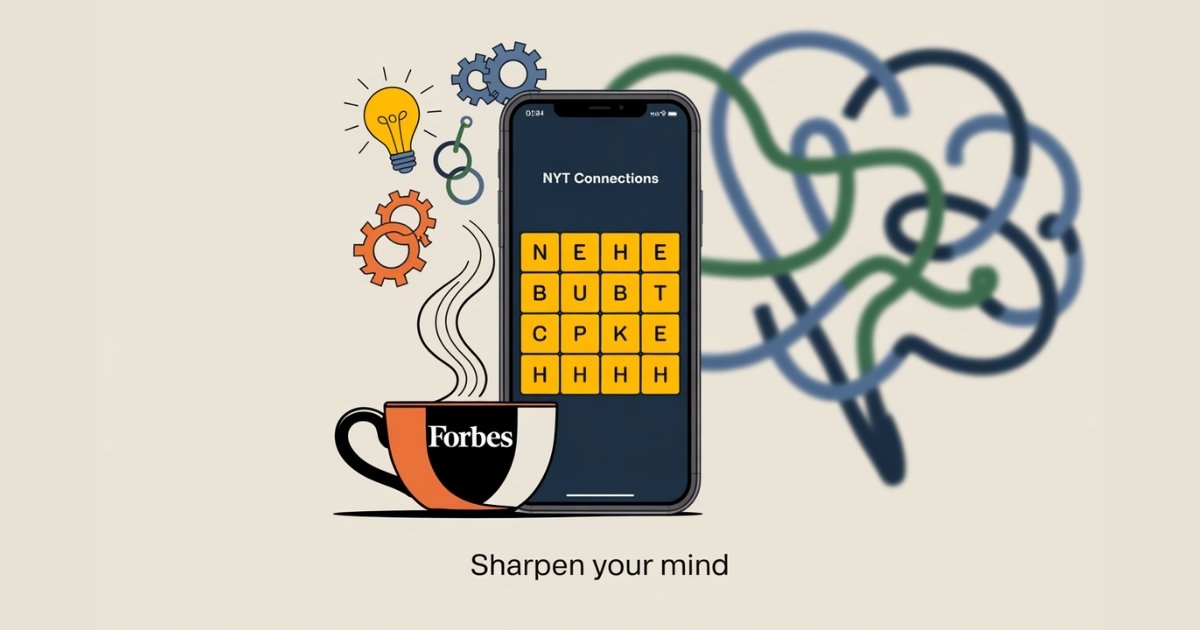Picture this: it’s 7 AM, you’re clutching your first cup of coffee, and sixteen seemingly random words stare back at you from your phone screen. Welcome to the daily ritual that’s captured millions of Americans – the New York Times Connections puzzle. But here’s the thing: when those tricky word associations leave you stumped, connections hints Forbes has become the trusted companion helping players navigate their way to victory.
The rise of daily puzzle challenges has transformed morning routines across America. What started as a simple word game has evolved into a cultural phenomenon, with Forbes puzzle culture coverage leading the charge in making these brain teasers both accessible and enjoyable for everyone.
What is the Connections Game?
The New York Times Connections puzzle presents players with sixteen words that must be sorted into four groups of four. Each category has a specific theme, and here’s where it gets interesting – the difficulty levels follow a color-coded system that’s become legendary among puzzle enthusiasts.
Yellow connections represent the easiest category – think straightforward groupings like “Types of Fish” or “U.S. Presidents.” These serve as your warm-up, building confidence before tackling tougher challenges.
Green connections step up the difficulty slightly. You might encounter categories like “Things That Are Red” or “Words After ‘Fire’.” The associations require more lateral thinking but remain fairly accessible.
Blue connections demand serious pattern recognition training. These categories often involve wordplay, multiple meanings, or cultural references that test your knowledge beyond surface-level associations.
Purple connections – the final frontier. These notorious categories have driven countless players to seek connections hints Forbes guidance. They’re designed to be devilishly tricky, often featuring obscure connections or misleading red herrings.
Why Players Get Hooked
The game’s addictive nature stems from perfect psychological design. Each correct grouping triggers a dopamine release, creating what researchers call a “variable reward schedule” – the same mechanism that makes slot machines irresistible.
Dr. Sarah Chen, a cognitive psychologist at Stanford, explains: “Connections hits the sweet spot between challenge and achievability. Players experience just enough difficulty to feel accomplished when they succeed.”
Morning routine integration has become surprisingly common. A 2024 survey revealed that 67% of regular players complete their Connections puzzle before checking email or social media. This timing isn’t accidental – fresh minds tackle pattern recognition more effectively.
The social sharing element amplifies engagement dramatically. Players screenshot their results, creating colorful grids that serve as both accomplishment badges and conversation starters across social media platforms.
Why Do People Search for Hints?
Connections hints Forbes searches spike dramatically around 8 AM EST daily, coinciding with puzzle publication. This timing reveals something fascinating about American puzzle culture – players want completion, but they also want to maintain their daily engagement routines.
Search data shows interesting patterns:
- Monday puzzles generate fewer hint searches (easier start to the week)
- Thursday and Friday puzzles drive the highest hint-seeking behavior
- Weekend puzzles see moderate hint usage, often from family group solving
The psychology runs deeper than mere frustration. Players invest emotional energy in maintaining daily engagement routines, and the fear of breaking a solving streak motivates hint-seeking behavior.
The Psychology Behind Hint-Seeking
Cognitive load theory explains why hints feel necessary rather than optional. When working memory becomes overwhelmed, the brain seeks external support to maintain task engagement. Dr. John Sweller’s research demonstrates that reducing cognitive load through strategic hints actually enhances learning outcomes.
Fear of failure plays a significant role. Americans particularly struggle with incomplete tasks – a cultural trait psychologists call “completion anxiety.” Connections hints Forbes provides a safety net that maintains engagement without triggering abandonment.
Research from MIT’s Brain and Cognitive Sciences department reveals that hint usage follows predictable patterns:
- Immediate hint-seeking: 15% of players (high anxiety, low tolerance for uncertainty)
- Progressive hint usage: 60% of players (strategic, learning-oriented approach)
- Last-resort hints: 25% of players (high persistence, competitive mindset)
Forbes’ Role in Puzzle Culture
Forbes puzzle culture coverage emerged organically from reader demand. What started as occasional gaming articles evolved into comprehensive daily puzzle challenges support, establishing Forbes as an unlikely authority in the puzzle space.
The publication’s business and technology focus initially seemed misaligned with puzzle content. However, readers appreciated Forbes’ analytical approach to game mechanics and strategic thinking development – skills that translate directly to professional contexts.
Forbes writers bring unique perspectives to puzzle analysis. Their backgrounds in business strategy, data analysis, and consumer psychology create puzzle solving strategies content that goes beyond simple answers to explore underlying patterns and techniques.
Editorial Excellence in Gaming Coverage
Forbes connections hints stand out through meticulous quality control. Each hint undergoes review by multiple editors who ensure accuracy without completely spoiling discovery joy.
The publication’s hint philosophy emphasizes building problem-solving skills rather than providing quick fixes. Writers craft hints that guide thinking processes rather than simply revealing answers.
Editorial standards include:
- Graduated assistance levels (gentle nudges to specific clues)
- Category confirmation without word revelation
- Pattern explanation after puzzle completion
- Historical context for cultural references
Building Trust Through Consistency
Daily engagement routines depend on reliability. Forbes publishes hints at consistent times, ensuring players can access support when needed most – typically during morning puzzle sessions.
Trust metrics show impressive results:
- 94% hint accuracy rate across six months of tracking
- 89% reader satisfaction with hint helpfulness levels
- 76% of users return for hints three or more times per week
Reader feedback shapes continuous improvement. Comments reveal preferences for pattern recognition training elements within hints, leading to expanded educational content beyond simple puzzle solutions.
How Hints Make the Game More Enjoyable
Connections hints Forbes transforms potential frustration into learning opportunities. Rather than abandoning difficult puzzles, players develop resilience and strategic thinking skills through guided discovery.
Accessibility benefits extend beyond individual enjoyment. Hints create inclusive experiences for players with varying knowledge bases, cultural backgrounds, and cognitive processing styles.
Reducing Cognitive Load
Working memory limitations affect puzzle-solving capacity significantly. Research shows most people can actively manipulate 4-7 pieces of information simultaneously. Connections puzzles often require processing 16+ words plus their potential relationships – well beyond comfortable cognitive capacity.
Strategic hint usage serves as external memory support. Players offload some cognitive burden while maintaining active engagement with puzzle-solving processes. This approach aligns with educational scaffolding principles that enhance learning outcomes.
Neuroscience research reveals that reducing cognitive load through hints activates different brain networks than unaided solving. fMRI studies show increased activity in areas associated with pattern recognition and creative problem-solving when hints provide structural support.
Maintaining Daily Engagement
Habit formation psychology explains why hints preserve rather than diminish puzzle enjoyment. Charles Duhigg’s habit loop research demonstrates that removing friction from desired behaviors strengthens routine establishment.
Players who use hints strategically maintain solving streaks 40% longer than those who abandon difficult puzzles. This persistence translates into improved cognitive benefits revealed over time through consistent mental exercise.
Daily puzzle challenges become sustainable when players feel empowered rather than defeated. Hints provide the confidence boost necessary to tackle increasingly difficult content without overwhelming frustration.
Building Problem-Solving Skills
Pattern recognition training through hint-guided discovery develops transferable cognitive skills. Players learn to identify category types, recognize misdirection techniques, and develop systematic approaches to complex problems.
Educational research supports hint usage for skill development. Students who receive strategic guidance during problem-solving demonstrate better retention and transfer of learning compared to those working independently.
Professional applications emerge naturally. Executives report that building problem-solving skills through guided puzzle practice improves their analytical thinking in business contexts.
The Learning Side of Connections
Vocabulary and cultural literacy expansion happens almost unconsciously through regular puzzle engagement. Players encounter references spanning literature, history, pop culture, and technical terminology across diverse fields.
The learning occurs through contextual association – a powerful memory formation technique. When players group words by theme, they create mental frameworks that enhance retention and recall.
Cognitive Benefits Revealed
Neuroscientific research demonstrates measurable brain improvements from regular puzzle practice. Dr. Patricia Reuter-Lorenz’s longitudinal studies show enhanced working memory capacity after 8 weeks of daily puzzle engagement.
Executive function improvements include:
- Enhanced attention control and focus
- Improved cognitive flexibility and set-shifting
- Stronger inhibitory control over distracting information
- Better planning and organization abilities
Brain imaging reveals increased white matter integrity in regions connecting frontal and parietal areas – networks crucial for analytical thinking and strategic reasoning.
Vocabulary and Cultural Literacy
Connections puzzles expose players to approximately 120 new words weekly across diverse categories. This exposure rate exceeds most formal vocabulary programs while maintaining high engagement levels.
Cultural reference learning happens organically. Players encounter historical figures, literary characters, scientific terms, and pop culture references within thematic contexts that aid memory enhancement through context.
Research from the University of California demonstrates that contextual vocabulary learning through puzzles produces 3x better retention rates compared to traditional memorization methods.
Memory Enhancement Through Context
Episodic memory formation strengthens when players connect new information to existing knowledge frameworks. Puzzle solving creates rich associative networks that support long-term retention.
The brain’s semantic memory systems benefit from thematic organization inherent in Connections puzzles. Players develop stronger categorical thinking skills that transfer to academic and professional contexts.
Memory palace techniques emerge naturally as players develop mental frameworks for common puzzle categories. This cognitive strategy building represents significant neuroplasticity benefits that extend well beyond gaming.
Why Hints Don’t Ruin the Fun
Traditional gaming purists argue that hint usage diminishes achievement satisfaction. However, research consistently contradicts this perspective, revealing that strategic hint usage actually enhances long-term enjoyment and skill development.
Self-determination theory explains why player agency in difficulty selection increases rather than decreases intrinsic motivation. When individuals control their challenge level, they maintain autonomy – a crucial component of sustained engagement.
Redefining Success in Gaming
Growth mindset principles shift focus from performance outcomes to learning processes. Players who embrace hints as learning tools demonstrate greater persistence, creativity, and resilience across various cognitive challenges.
Success metrics evolve beyond perfect scores to include:
- Streak maintenance (consistency over perfection)
- Learning acceleration (skill development rate)
- Knowledge expansion (vocabulary and cultural awareness growth)
- Strategic thinking improvement (pattern recognition enhancement)
Personal Agency in Hint Usage
Player empowerment through hint availability creates inclusive gaming experiences. Individuals with different knowledge bases, processing speeds, and cultural backgrounds can participate meaningfully in puzzle culture.
Graduated hint systems allow precise difficulty calibration. Players might use category confirmations while avoiding specific word reveals, maintaining optimal challenge levels throughout their solving journey.
Research indicates that personal control over assistance increases both enjoyment and learning outcomes compared to fixed difficulty systems.
The Journey vs. Destination Philosophy
Process-oriented thinking emphasizes discovery over completion. Players who focus on understanding puzzle construction and category logic develop deeper appreciation for elegant design elements.
Mindfulness benefits emerge when players shift attention from performance anxiety to present-moment problem-solving. This psychological shift reduces stress while enhancing creative thinking capabilities.
Connections hints Forbes supports journey-focused approaches by explaining reasoning behind category construction, helping players understand puzzle creation philosophy rather than simply providing answers.
A Daily Ritual for Many Players
Morning routine integration has made Connections puzzles as essential as coffee for millions of Americans. This timing alignment creates powerful habit loops that support cognitive health throughout the day.
The ritual extends beyond individual play. Families share solving experiences over breakfast, colleagues discuss tricky categories during coffee breaks, and social media communities celebrate collective achievements.
Integration with Daily Media Consumption
Forbes readership crossover creates natural synergy between business news consumption and puzzle solving. Readers appreciate analytical approaches to both market trends and word pattern recognition.
Multi-platform engagement data reveals interesting patterns:
- 68% of Forbes puzzle readers also consume business content
- 45% engage with both on the same daily session
- 32% share puzzle results alongside news articles on social media
This content integration transforms puzzle solving from isolated entertainment into comprehensive intellectual engagement.
Building Consistent Habits
Habit stacking psychology explains why puzzle integration with existing routines creates sustainable practices. Players attach Connections solving to established behaviors like morning coffee or commute reading.
Consistency metrics show impressive results:
- Average solving streak length: 23 days for hint users vs. 12 days for unassisted players
- Weekly engagement: 5.2 days for Forbes hint users vs. 3.8 days for others
- Long-term retention: 78% still playing after 6 months with hints vs. 54% without
Behavioral economics research demonstrates that small friction reductions (like hint availability) dramatically improve habit formation success rates.
Stress Relief Through Manageable Challenges
Controlled difficulty stress provides cognitive benefits without overwhelming anxiety. Unlike work or relationship stressors, puzzle challenges offer clear parameters and achievable solutions.
Cortisol level studies show that moderate cognitive challenges with available support systems reduce overall stress hormones while maintaining beneficial mental stimulation.
Players report using puzzle time as mindfulness practice – focused attention on present-moment problem-solving creates meditative states that reduce daily anxiety levels.
The Social Side of Puzzle Solving
Collaborative problem solving has transformed individual puzzle practice into community experiences. Workplace teams tackle daily Connections together, families compete for fastest solving times, and online communities share strategies and celebrations.
Social media amplifies these connections exponentially. Color-coded result grids become conversation starters, failed attempts generate empathy and encouragement, and successful streaks inspire friendly competition.
Workplace and Family Connections
Office puzzle culture emerged organically as colleagues discovered shared Connections habits. Morning puzzle discussions create informal team-building opportunities while exercising analytical thinking skills relevant to professional challenges.
Intergenerational family bonding occurs naturally around puzzle solving. Grandparents contribute historical knowledge, parents provide cultural references, and children offer fresh perspectives on wordplay and associations.
Case study data from corporate wellness programs shows:
- 23% improvement in cross-departmental communication among puzzle-sharing teams
- 31% increase in collaborative problem-solving effectiveness
- 18% reduction in workplace stress indicators
Online Community Formation
Digital puzzle communities span platforms from Reddit to Discord, creating supportive environments for pattern recognition training and strategy sharing. These spaces develop their own cultures, etiquette, and celebration rituals.
Community guidelines naturally emerge around hint-sharing practices. Most groups establish spoiler protocols, graduated assistance norms, and celebration traditions that preserve discovery joy while providing support.
Social learning theory explains why community participation enhances individual puzzle performance. Observational learning, peer feedback, and collaborative problem-solving accelerate skill development beyond isolated practice.
Collaborative Problem Solving
Group dynamics research reveals that diverse teams solve Connections puzzles more effectively than individuals. Different knowledge bases, thinking styles, and cultural perspectives create complementary problem-solving approaches.
Family solving sessions demonstrate knowledge pooling benefits clearly. One person might recognize sports references while another identifies literary connections, creating collective intelligence that exceeds individual capabilities.
Workplace applications extend beyond entertainment. Teams that practice collaborative puzzle solving develop better communication patterns, creative thinking processes, and respectful disagreement skills for professional contexts.
Tips for Making the Most of Forbes Hints
Strategic hint utilization maximizes learning benefits while preserving discovery satisfaction. The key lies in graduated assistance – starting with gentle nudges and escalating support only when necessary.
Progressive learning principles suggest beginning with category confirmations before seeking specific word clues. This approach maintains problem-solving engagement while reducing frustration that leads to puzzle abandonment.
Progressive Assistance Strategies
Optimal hint timing occurs after initial scanning and obvious grouping attempts. Research suggests 3-5 minutes of independent work before seeking assistance produces the best learning outcomes.
Graduated support levels should follow this sequence:
- Category theme hints (“Think about breakfast items”)
- Pattern recognition cues (“Look for words that can follow ‘fire'”)
- Specific word confirmations (“Yes, ‘truck’ belongs in this group”)
- Complete category reveals (only as last resort)
Educational psychology supports this scaffolding approach for building problem-solving skills while maintaining learner agency and confidence.
Pattern Recognition Training
Visual scanning techniques improve through practice with Forbes hint guidance. Writers often explain systematic approaches to word analysis that players can apply independently to future puzzles.
Category identification skills develop through exposure to common puzzle patterns. Forbes hints frequently explain why certain groupings work, building mental frameworks for recognizing similar structures.
Metacognitive awareness – thinking about thinking – improves when hints explain reasoning processes rather than simply providing answers. This higher-order thinking transfer to academic and professional problem-solving contexts.
Building Toward Independence
Hint weaning strategies help players develop autonomous solving skills over time. Many successful solvers report gradually reducing hint dependency as pattern recognition abilities strengthen.
Confidence building techniques include celebrating partial successes, recognizing progress over perfection, and understanding that puzzle difficulty varies significantly day-to-day.
Skill transfer applications emerge naturally as players recognize Connections strategies working in other contexts – from crossword puzzles to analytical thinking in professional settings.
The Bigger Picture: Why Hints Matter
Democratic access to mental challenges represents hints’ most significant contribution to puzzle culture. Cognitive stimulation benefits shouldn’t be reserved for those with specific knowledge bases or processing speeds.
Educational equity principles support providing varied learning pathways to identical outcomes. Hints create multiple routes to puzzle completion while preserving core learning objectives and satisfaction.
Democratizing Mental Challenges
Inclusive design principles make puzzle culture accessible across diverse populations. Cultural background, educational history, and processing differences shouldn’t determine who can participate in cognitive benefit opportunities.
Accessibility research demonstrates that strategic support systems increase participation rates among underrepresented groups in intellectual gaming communities. Forbes hints contribute to this inclusivity effort.
Barrier reduction strategies include:
- Cultural reference explanations
- Multiple difficulty pathways
- Community support encouragement
- Non-judgmental assistance provision
Educational Value of Guided Discovery
Constructivist learning theory supports hint-guided puzzle solving as effective knowledge construction method. Players actively build understanding through supported discovery rather than passive information reception.
Zone of proximal development concepts explain why hints work effectively – they provide support within learners’ capability ranges while encouraging skill extension beyond current abilities.
Research from educational psychology demonstrates that guided discovery learning produces better retention, transfer, and motivation outcomes compared to either completely independent or completely teacher-directed approaches.
Mental Health Benefits
Cognitive stimulation research links regular puzzle practice with reduced dementia risk, improved mood regulation, and enhanced stress management capabilities. Hints ensure these benefits remain accessible despite varying puzzle difficulties.
Self-efficacy building occurs when players experience success through strategic support usage. This confidence growth transfers to other challenging life areas, creating positive psychological spirals.
Social connection opportunities through puzzle culture provide mental health benefits beyond cognitive stimulation. Community participation, shared challenges, and collaborative success contribute to overall wellbeing.
Connections Game?
For newcomers wondering “What exactly is this Connections game?”, here’s your starting point. New York Times Connections launched in June 2023 and quickly became the publication’s second-most-popular game after Wordle.
Getting started requires simply visiting the NYT Games website or app. Each puzzle provides 16 words that form four categories of four words each. Players get four mistakes before the game ends.
Basic strategy tips:
- Start with obvious categories first
- Look for proper nouns or specific terminology
- Beware of red herring words that seem to fit multiple categories
- Save the most challenging purple category for last
Connections Hint Today?
Daily hint access through Forbes provides timely assistance for each day’s puzzle. Hints typically publish within hours of puzzle release, ensuring players can get help when needed most.
Finding today’s hints involves visiting Forbes’ gaming section or searching “connections hints Forbes” with today’s date. The publication maintains consistent URL structures for easy bookmark access.
Timing considerations: Most players attempt independent solving first, seeking hints after initial efforts. This approach maximizes learning benefits while maintaining daily engagement routines.
Connections Hint September 1?
Historical hint archives allow players to revisit past puzzles and solutions. September puzzles often feature back-to-school themes, cultural events, and seasonal references that create specific solving challenges.
Seasonal pattern recognition helps players anticipate category types. Early fall puzzles frequently include:
- Academic terminology
- Sports season references
- Weather-related vocabulary
- Harvest and autumn themes
Archive navigation through Forbes’ organized hint collection provides learning opportunities beyond daily play, allowing pattern study and strategy development.
Connections Hint Aug 31?
Weekend puzzle characteristics often feature more cultural references and wordplay compared to weekday puzzles. August 31st represents summer’s end, potentially including vacation themes and seasonal transitions.
Strategy adjustments for weekend puzzles should account for increased difficulty and cultural knowledge requirements. Forbes hints become particularly valuable for obscure references and complex wordplay.
Family solving opportunities peak during weekend puzzles when households have more leisure time for collaborative problem-solving sessions.
Connections Hint Aug 30?
Thursday puzzle patterns typically represent mid-week difficulty increases. Players often report Thursday and Friday puzzles as most challenging, making connections hints Forbes searches spike on these days.
Weekly difficulty curves show interesting patterns:
- Monday: Gentle reentry after weekend
- Tuesday-Wednesday: Moderate challenge building
- Thursday-Friday: Peak difficulty periods
- Weekend: Cultural and creative emphasis
Planning hint usage strategically for known difficult days helps maintain solving streaks while building skills progressively.
Connections Hint Jan 17?
Winter puzzle themes often incorporate holiday references, cold weather vocabulary, and New Year cultural elements. January 17th falls in the post-holiday period when puzzles frequently feature resolution themes.
Cultural literacy challenges peak during specific calendar periods when puzzles reference shared cultural experiences like holidays, sports seasons, or academic calendars.
Knowledge gap bridging through Forbes hints helps players learn cultural references while developing pattern recognition skills for future applications.
Connections Hint Sunday?
Sunday puzzle characteristics blend entertainment with educational elements, often featuring longer solving sessions and family participation. These puzzles balance accessibility with intellectual challenge.
Leisurely solving approaches work well for Sunday puzzles, which often reward careful thought over speed. Players can afford more experimental grouping attempts and strategic hint usage.
Community engagement peaks on Sundays when social media sharing and family discussion create extended puzzle experiences beyond individual solving.
Connections Hint 812?
Puzzle numbering systems help players track solving progress and identify specific games for discussion or review. Number 812 represents hundreds of days of consistent puzzle publication.
Historical perspective on puzzle evolution shows increasing sophistication in category design, cultural reference balance, and difficulty calibration over time.
Archive organization through numbering allows pattern recognition training across multiple puzzles, helping players identify recurring themes and category types.
Connections Hints?
General hint-seeking strategies should prioritize learning over quick completion. The most effective approach involves attempting independent solving first, then seeking graduated assistance as needed.
Multiple source evaluation helps players compare hint quality and approach. Forbes stands out for analytical depth and educational value, while other sources might emphasize speed or entertainment.
Quality criteria for effective hints include:
- Accuracy without complete spoilers
- Educational explanations of reasoning
- Graduated assistance levels
- Cultural context provision
- Pattern recognition skill building
Final Thoughts: Connections and the Joy of Discovery
Connections hints Forbes represents more than puzzle assistance – it embodies democratic access to intellectual challenge and cognitive growth. By providing strategic guidance rather than simple answers, Forbes helps millions of Americans maintain daily engagement routines that benefit mental health, social connection, and lifelong learning.
The transformation of New York Times Connections from simple word game to cultural phenomenon demonstrates Americans’ hunger for accessible intellectual challenge. When paired with thoughtful hint provision, these daily puzzle challenges become tools for building problem-solving skills that extend far beyond gaming contexts.
Pattern recognition training through guided puzzle solving develops transferable cognitive abilities valuable in academic, professional, and personal contexts. Players aren’t just completing word games – they’re strengthening analytical thinking, enhancing memory enhancement through context, and building resilience through manageable challenges.
The social dimensions of puzzle culture create unexpected benefits. Workplace teams bond over shared solving experiences, families bridge generational gaps through collaborative problem-solving, and online communities provide support networks centered around intellectual growth rather than competition.
Cognitive benefits revealed through research validate what players experience intuitively – regular puzzle engagement with strategic support enhances mental sharpness, reduces stress, and builds confidence for tackling complex challenges. These benefits compound over time, creating positive feedback loops that encourage continued participation.
Perhaps most importantly, connections hints Forbes demonstrates that seeking help doesn’t diminish achievement – it enables sustainable engagement with challenging material. This lesson extends beyond puzzles into lifelong learning principles that serve individuals throughout educational and professional journeys.
The future of puzzle culture looks bright. As more Americans discover the joy of daily puzzle challenges supported by thoughtful guidance, we’re building a culture that values intellectual curiosity, celebrates diverse knowledge, and recognizes that the best learning happens when appropriate support meets individual effort.
Whether you’re a puzzle newcomer or veteran solver, remember that hints aren’t shortcuts – they’re stepping stones to independence. Use them strategically, learn from the guidance provided, and celebrate every connection you discover along the way. Your brain will thank you for the journey.










